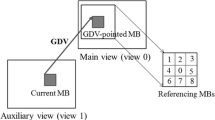Abstract
Multiview video coding (MVC) achieves an excellent coding gain using exhaustive variable size mode decision in intra-view prediction and inter-view prediction. However, the high computational complexity prevents it from real-time application. In this paper, a fast intra-view mode decision and inter-view prediction termination algorithm based on just noticeable distortion (JND) is proposed to speed up the search process of motion estimation (ME) and disparity estimation (DE). The basic idea of the method is to exploit JND threshold in mode prediction to make an early decision on the process of variable size ME and DE in MVC. We not only narrow down prediction mode size candidates, but also terminate the process of DE early. Experimental results demonstrate that the proposed algorithm is able to reduce the entire encoding time by 79.94 % on average among different views, with negligible loss of coding efficiency.






Similar content being viewed by others
References
A. Abdelazim et al., Fast prediction algorithm for multiview video coding. SPIE Opt. Eng. 52(3), 037401 (2013)
Z. Chen, C. Guillemot, Perceptually friendly H.264/AVC video coding based on foveated just noticeable distortion model. IEEE Trans. Circuits Syst. Video Technol. 20(6), 806–819 (2010)
L. Ding, P. Tsung, S. Chien, W. Chen, L. Chen, Content-aware prediction algorithm with inter-view mode decision for multiview video coding. IEEE Trans. Multimed. 10(8), 1553–1564 (2008)
ISO/IEC JTC1/SC29/WG11, Study Text of ISO/IEC 14496–5:2001/FPDAM 15 Reference Software for Multiview Video Coding, N10704 (2009)
ITU -R, Methodology for the subjective assessment of the quality of television pictures, ITU -R Recommendation BT. 500–11 (2002)
M. Li, M. Chen, in Fast HVS-Based Mode Decision for H.264/AVC Using Just-Noticeable-Difference. IEEE Conference on Computer Vision and Pattern Recognition (2011)
P. Merkle, A. Smolic, K. Mller, T. Wiegand, Efficient prediction structures for multi-view video coding. IEEE Trans. Circuits Syst. Video Technol. 17(11), 1461–1473 (2007)
L. Shen, Z. Liu, S. Liu, Z. Zhang, P. An, Selective disparity estimation and variable size motion estimation based on motion homogeneity for multi-view coding. IEEE Trans. Broadcast. 55(4), 761–766 (2009)
L. Shen, Z. Zhang, Fast mode decision algorithm for extended macroblock motion estimation in key technology areas. SPIE J. Electron. Imag. 21(2), 023009 (2012)
L. Shen, Z. Zhang, Content-adaptive motion estimation algorithm for coarse-grain SVC. IEEE Trans. Image Process. 21(5), 2582–2591 (2012)
M. Tanimoto, in Overview of FTV (free-viewpoint television). IEEE International Conference on Multimedia and Expo (2009), pp. 1552–1553
H. Wang, X. Qian, G. Liu, in Inter Mode Decision Based on Just Noticeable Difference Profile. International Conference on Image Processing (2010), pp. 297–300
X. Yang, W. Lin, Z. Lu, E. Ong, S. Yao, Motion-compensated residue preprocessing in video coding based on just-noticeable-distortion profile. IEEE Trans. Circuits Syst. Video Technol. 15(6), 742–750 (2005)
L. Zhang, W.J. Tam, Stereoscopic image generation based on depth images for 3DTV. IEEE Trans. Broadcast. 51(2), 191–199 (2005)
H. Zeng, K. Ma, C. Cai, Fast mode decision for multiview video coding using mode correlation. IEEE Trans. Circuits Syst. Video Technol. 21(11), 1659–1666 (2011)
W. Zhu, X. Tian, F. Zhou, Y. Chen, Fast inter mode decision based on textural segmentation and correlations for multiview video coding. IEEE Trans. Consum. Electron. 56(3), 1696–1704 (2010)
Y. Zhang, S. Kwong, G. Jiang, X. Wang, M. Yu, Statistical early termination model for fast mode decision and reference frame selection in multiview video coding. IEEE Trans. Broadcast. 58(1), 10–23 (2012)
T. Zhao, S. Kwong, H. Wang, Z. Wang, Z. Pan, C.-C.J. Kuo, Multiview coding mode decision with hybrid optimal stopping model. IEEE Trans. Image Process. 22(4), 1598–1609 (2013)
B. Zatt, M. Shafique, S. Bampi, J. Henkel, in A Multi-level Dynamic Complexity Reduction Scheme for Multiview Video Coding. International Conference on Image Processing (2011), pp. 749–752
Acknowledgments
This work was supported by Natural Science Foundation of China under Grant Nos. 61301113, 60972137 and 60832003, and Shanghai National Natural Science under Grant No.13ZR1416500.
Author information
Authors and Affiliations
Corresponding author
Rights and permissions
About this article
Cite this article
Shang, X., Wang, Y., Luo, L. et al. Fast Mode Decision for Multiview Video Coding Based on Just Noticeable Distortion Profile. Circuits Syst Signal Process 34, 301–320 (2015). https://doi.org/10.1007/s00034-014-9851-0
Received:
Revised:
Accepted:
Published:
Issue Date:
DOI: https://doi.org/10.1007/s00034-014-9851-0




